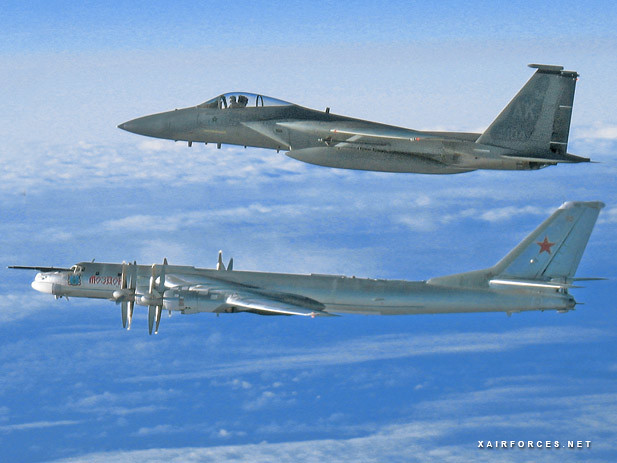I was fascinated by this exchange during Katie Couric’s interview of Sarah Palin the other night:
Couric: Have you ever been involved in any negotiations, for example, with the Russians?
Palin: We have trade missions back and forth, we do. It’s very important when you consider even national security issues with Russia. As Putin rears his head and comes into the air space of the United States of America, where do they go? It’s Alaska. It’s just right over the border. It is from Alaska that we send those out to make sure that an eye is being kept on this very powerful nation, Russia, because they are right there, they are right next to our state.
So, what was Sarah Palin trying to say there? Well, it’s clear enough that when she said “As Putin rears his head and comes into the air space of the United States of America . . . ” she was talking about Russian aircraft flying into the air defense identification zone surrounding Alaska. But what did she mean when she said “It is from Alaska that we send those out . . .”? Those what?
Given that she started out talking about Russian flights into the ADIZ, she probably meant to imply that she was responsible for launching Alaska-based fighter aircraft to intercept Putin’s sky bandits. That might have bolstered her leadership and foreign policy cred, especially with people who want to believe in Sarah Palin in the first place. After all, as governor of Alaska, she defends its airspace, doesn’t she? So there, skeptics!
Except, of course, the governor of Alaska has nothing to do with air defense launches. That’s strictly a North American Air Defense Command (NORAD) affair, and as far as I know the first notice any Alaskan politician would ever get of one of these intercepts would be in the Anchorage Daily Times.
I flew several such intecepts between 1982 and 1985, when I was an F-15 pilot at Elmendorf AFB, near Anchorage, Alaska. We always had two jets on five-minute alert at each of two remote locations, King Salmon and Galena. King Salmon was on the Alaskan Peninsula, about 300 miles southwest of Anchorage, not too far from the Bering Strait and the Aleutian Islands. Galena was on the Yukon River, 300 miles north-northwest of Anchorage, 300 miles south of Barrow, more or less in the middle of the state.
As I mentioned, we were under NORAD control. When the Soviets flew missions into the ADIZ near the Aleutians or the Bering Strait, NORAD would scramble the jets at King to intercept them. The Soviet Aleutian flights were usually conducted by long-range Bear bombers, but we also intercepted Badgers, and once, memorably, a Bison. The Bering Strait flights were usually ice patrols flown by a small AN-24 twin turboprop we called a Colt. The Colt was the hard one. The propellors threw off all sorts of radar glint, confusing the hell out of ground-based controllers, and once you closed with the damn thing, it was so slow you had to fly an S-shaped or racetrack pattern to keep from zooming right past it.
The Galena intercepts were the most interesting, though, several levels of complexity and intensity over the relatively close-in action out of King Salmon. The Soviets would launch Bear bombers out of their bases in Siberia, then vector them north over the Pole. If the Bears were bound for the western USSR, they’d come back down near Iceland, and USAF F-15s based at Keflavik would intercept them under North Atlantic Treaty Organization (NATO) control. If the Bears turned back toward Siberia, though, they’d come back down north of Barrow, Alaska, and NORAD would launch the Galena alert birds.
The intercept I remember most vividly was our first look at a new and as yet unseen (by the West, anyway) version of the Bear, the Bear H, then being built as a cruise missile carrier. We knew the Bear H had been deployed to the USSR’s Far Eastern Military District and was flying missions, and that NORAD and NATO were hot to intercept and photograph one.
I was lead pilot on alert at Galena on a typical 40-below winter day when we got a warning call from NORAD telling us to suit up. Normally scrambles came with no warning; getting a heads-up call first meant something was definitely up. A few minutes later the klaxon went off and we scrambled on a northerly vector toward Barrow and the Arctic ice pack. A KC-135 tanker was waiting for us near Barrow, and after we refueled the controller pointed us north again, this time toward the Pole. About this time AWACS took over, and it dawned on me we were going after a Bear H . . . they wouldn’t have launched two fighters, a tanker, and an AWACS for anything less.
Headed north over the ice, my wingman and I had plenty of time to think about our survival chances should anything go wrong. A perennial Alaskan F-15 pilot joke was that the real purpose of the pistol you carried on your survival vest was to shoot yourself before the bears got you, but we figured to freeze to death long before then. Then, more than a hundred miles ahead, we saw two thin contrails . . . our targets. At a combined closure speed of over 1,000 knots, it didn’t take long to close the distance. There they were, one dirty gray generic Bear, twenty years old or older (just like our own B-52s) and one shiny silver H model right out of the box, flying formation. We closed in, and with one of us always back at the Bears’ six in cover position, took turns flying photo passes on the Bear H.
We carried Canon AE-1 cameras with telephoto lenses and motor drives, a real handful. If your mitts were big enough you could hold, aim, focus, and shoot with one hand while flying with the other. Mine weren’t, so I had to use both of them for the camera while working the stick with my knees. The Soviet pilots were watching closely, of course, and each time they saw you lift up that big camera they’d bank into you, forcing you to put the camera down and pull back on the stick to avoid a midair. You had to be quick.
During the ten minutes our remaining fuel allowed us to stay with them, we managed to shoot three or four rolls of film of the Bear H. Finally we waved goodbye and turned south, back toward Galena. As we took a few thousand pounds of fuel each off the tanker near Barrow, we heard AWACs checking in the bros from King Salmon . . . NORAD had scrambled all four of us, and the King jets wound up getting another four rolls of film before the Bears got too close to the USSR to continue.
When we landed at Galena, after the requisite fast & low mission-successful airfield fly-by, intel met us at the jets and confiscated our cameras and film. There was a C-12 waiting on the ramp to fly the film back to Elmendorf, and twelve hours later Ronald Reagan, sitting in the Oval Office, was looking at prints of photos I’d taken.
Damn, those were exciting times. The only personal photos I have from that mission (taken with a personal camera that would have cost me my career had I been caught with it in my cockpit) are so bad as to be useless, so I’ve taken the liberty of downloading a couple of generic (i.e., not me) Alaska F-15 intercept photos from the net. I hope they give you some idea of how awesome those intercept flights were . . . for us and the Russians.
* Putin Rears His Head image stolen from Boing Boing.


Nice job, Eagle Driver. Thanks for manning the frontier.
I respectfully dispute your assertion, though. It appears that nowadays the Alaskan Air Defense Sector is controlled by the 176th Air Control Squadron, an ANG unit attached to NORAD. So yes, Gov. Palin does get told when her troops run into the bear.
I wrote a post about this at
http://blog.bbbeard.com/2008/10/01/adiz-zy-about-sarah/
Well, bbbeard, I hope I’m not one of the “idiot bloggers” you refuse to link to! Having an ANG unit control an air defense sector is, I think, a fairly recent development, and given the information you provide, I happily retract my statement that the Alaska governor isn’t informed of intercepts within the Alaskan ADIZ as they happen. The governor is not, however, part of the operational chain of command, and it was a deliberately misleading stretch for her to imply that she somehow directs the intercepts. Even if she did leave out the words “bombers,” “fighters,” and “interceptions.”
No, you’re not one of the idiots! I was referring to a sadly typical DailyKos thread, in which all kinds of crazy memes were trial-ballooned [is that a verb?]….